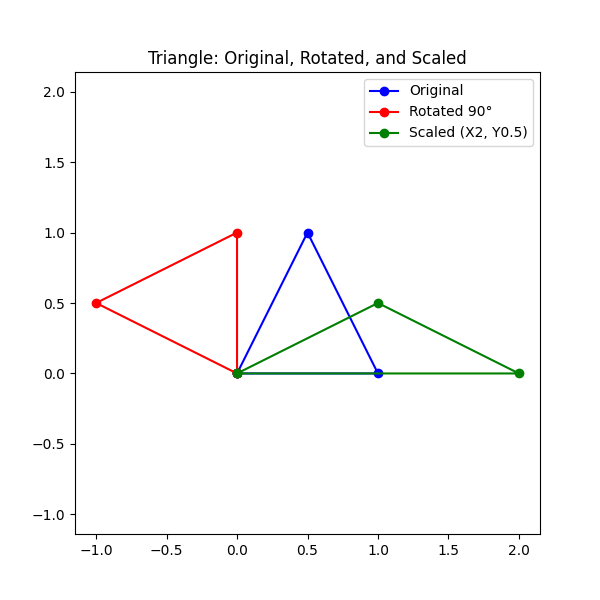Hi Pythonistas!
Last prost I explored how our computer to compare sentences, and today I’m diving into the math that powers so much of AI, graphics, and robotics: matrix multiplication and 2D transformations. If you’ve ever wondered how video games spin characters or photos resize smoothly, matrix math is the key!
What’s a Matrix?
Think of a matrix as a grid or table of numbers like a spreadsheet. Matrices help computers handle lots of numbers at once. Multiplying them applies transformations, mixes data, or feeds inputs through neural networks.
Matrix Multiplication: The Core Idea
Multiplying matrix A by B blends the rows of A with the columns of B to create a new matrix. This is how data or shapes get transformed.
Let’s Transform a Triangle!
Step 1: Define a Triangle
import numpy as np
triangle = np.array([
[0, 0],
[1, 0],
[0.5, 1]
])Step 2: Rotation Matrix (Rotate 90°)
import math
angle = math.radians(90)
rotation = np.array([
[math.cos(angle), -math.sin(angle)],
[math.sin(angle), math.cos(angle)]
])Step 3: Scaling Matrix (Double Size on X, Half on Y)
scaling = np.array([
[2.0, 0.0],
[0.0, 0.5]
])Step 4: Apply Transformations
rotated_triangle = triangle @ rotation.T
scaled_triangle = triangle @ scaling.TStep 5: Visualize Original, Rotated, and Scaled Triangles
import matplotlib.pyplot as plt
def plot_shape(points, color, label):
plt.plot(*zip(*(np.vstack([points, points[0]]))), color=color, marker='o', label=label)
plt.figure(figsize=(6,6))
plot_shape(triangle, 'blue', 'Original')
plot_shape(rotated_triangle, 'red', 'Rotated 90°')
plot_shape(scaled_triangle, 'green', 'Scaled (X2, Y0.5)')
plt.axis('equal')
plt.legend()
plt.title('Triangle: Original, Rotated, and Scaled')
plt.show()Output

Practical Uses of These Transformations
- Computer Graphics & Games: Rotations, scalings, and translations make game characters move, spin, and grow.
- Machine Learning & Neural Networks: Data and weights multiply as matrices to train AI models efficiently.
- Image Processing: Resize or rotate photos, create data variations to improve AI training.
- Robotics & Engineering: Robots calculate position changes and moves using these math tools.
- Data Science & Analytics: Transform and reduce data dimensions to spot patterns and simplify analysis.
What I Learned Today
- Matrix multiplication adjusts every point in a shape at once rotating or scaling the entire shape.
- These basic transformations are foundational to complex computer vision, AI, and graphics.
What’s Next?
In the upcoming post we will learn about norms and distance in vector